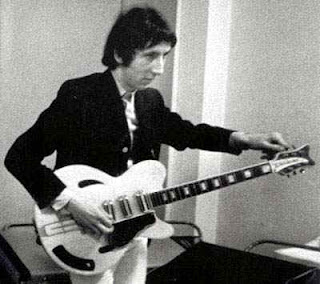Pete Townshend's career with The Who spans more than forty years, during which time the band grew to be considered one of the most influential bands of the 60s and 70s.
Townshend is the primary songwriter for The Who, having written well over one hundred songs for the band's eleven studio albums, including concept albums and the rock operas Tommy and Quadrophenia, plus popular rock and roll radio staples like Who's Next, and dozens more that appeared as non-album singles, bonus tracks on reissues, and tracks on rarities compilations like Odds & Sods.
He has also written over one hundred songs that have appeared on his solo albums, as well as radio jingles and television theme songs.
Although known primarily as a guitarist, he also plays other instruments such as keyboards, banjo, accordion, synthesiser, bass guitar and drums, on his own solo albums, several Who albums, and as a guest contributor to a wide array of other artists' recordings. Townshend has never had formal lessons in any of the instruments he plays.
Townshend has also been a contributor and author of newspaper and magazine articles, book reviews, essays, books, and scripts, as well as collaborating as a lyricist (and composer) for many other musical acts. Townshend was ranked #3 in Dave Marsh's list of Best Guitarists in The New Book of Rock Lists, #10 in Gibson.com's list of the top fifty guitarists, and #50 in Rolling Stone magazine's 2003 list: 100 Greatest Guitarists of All Time.
Townshend was inducted into the Rock and Roll Hall of Fame as a member of The Who in 1990.
(Continued below video and Amazon portals ...)
(Press album cover for direct link to the entire Amazon Website):

-----
Peter Dennis Blandford "Pete" Townshend was born into a musical family in Chiswick, London, England. His father was a professional saxophonist in The Squadronaires and his mother was a singer. Townshend became interested in music at an early age. His mother has said he watched the 1956 film Rock Around the Clock numerous times.
When he was 12, his grandmother gave him his first guitar. In 1961, Townshend enrolled at Ealing Art College, intending to become a graphic artist. He and his school friend from Acton County Grammar School John Entwistle founded their first band, The Confederates, a Dixieland duet featuring Townshend on banjo and Entwistle on horns. From this beginning they moved on to The Detours, a skiffle/rock and roll band fronted by Roger Daltrey, another former schoolmate.
In early 1964, because another band had the same name, The Detours renamed themselves The Who. Drummer Doug Sandom was replaced by Keith Moon not long afterwards.
The band - now with Daltrey on lead vocals and harmonica, Townshend on guitar, Entwistle on bass guitar and french horn, and Moon on drums - were soon taken on by a mod publicist named Peter Meaden who convinced them to change their name to The High Numbers to give the band more of a mod feel. After bringing out one failed single ("I'm the Face/Zoot Suit"), they dropped Meaden and were signed on by two new managers, Chris Stamp and Kit Lambert, who had paired up with the intention of finding new talent and creating a documentary about them.
The band anguished over a name that all felt represented the band best, and dropped The High Numbers name, reverting to The Who.
After "re-becoming" The Who, Townshend wrote several successful singles for the band, including "I Can't Explain," "Pictures of Lily," "Substitute," and "My Generation." Townshend became known for his eccentric stage style during the band's early days, often interrupting concerts with lengthy introductions of songs, swinging his right arm against the guitar strings in his signature move; a windmill style, often smashing guitars on stage, and often repeatedly throwing his guitars into his amplifiers and speaker cabinets.
The first incident of guitar-smashing was brought about because Townshend accidentally broke the neck of his guitar on the low roof of an early concert venue at the Railway Tavern in Harrow. The stage whilst only being about a foot high brought the roof to within less than 7 feet. It was an accident waiting to happen.
After smashing the instrument to pieces, he carried on by grabbing another guitar and acting as if the broken guitar had been part of the act. Drummer Keith Moon was delighted; he loved attention and destruction on any level, and smashed his drum kit as well. The press sensationalised the incidents. The on-stage destruction of instruments soon became a regular part of The Who's performances that was further dramatised with pyrotechnics, - an idea which came from Moon, made famous by his exploding drum kits.
-----
Townshend is recognized as one of the key figures in the development of feedback in rock guitar. When asked who first used feedback, Deep Purple guitarist Ritchie Blackmore said, "Pete Townshend was definitely the first. But not being that good a guitarist, he used to just sort of crash chords and let the guitar feedback. He didn't get into twiddling with the dials on the amplifier until much later.
-----
For more about Pete and The Who, visit this Website:
http://thewho.com/
####







No comments:
Post a Comment
PLEASE LEAVE A COMMENT